To learn more about the plants in the map above, select a species or scroll down.
- Catalina Island mountain-mahogany
Cercocarpus traskiae - San Clemente Island bush mallow
Malacothamnus clementinus - San Clemente Island Indian paintbrush
Castilleja grisea - San Clemente Island larkspur
Delphinium variegatum ssp. kinkiense
- San Clemente Island lotus
Acmispon dendroideus var. traskiae - San Clemente Island woodland star
Lithophragma maximum - Santa Cruz Island rock cress
Sibara filifolia - Island rush-rose
Crocanthemum greenei
Catalina Island mountain-mahogany, Cercocarpus traskiae
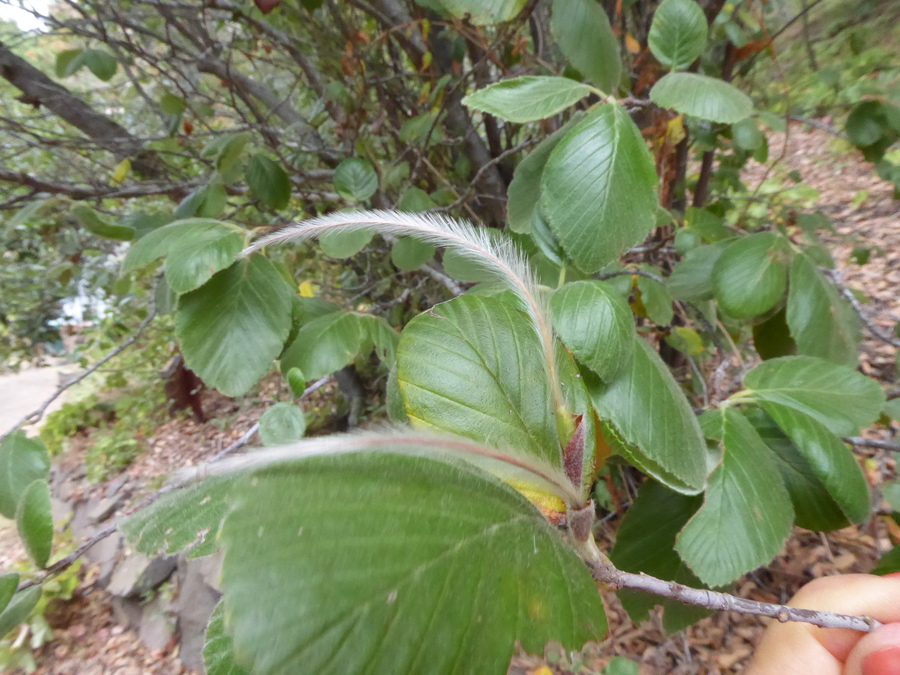
STATUS
Federal status: Endangered
State status: Endangered
POPULATION TREND
(=) Stable
RESTORATION
Favorable
FAMILY
Rosaceae, the rose family
RANGE
Endemic to Santa Catalina Island
Appearance
An evergreen shrub or small tree that blooms from March to May. While the Catalina Island mountain-mahogany is in the rose family, its white, woolly flowers are petal-less. They bloom from March to May. The leathery, oval leaves have serrated edges and white, woolly undersides. They have a simple structure and grow alternate on the stem.
Habitat
Catalina Island mountain-mahogany occurs in steep, narrow canyons, where it grows on dry, rocky soils among other plants in the coastal sage scrub community. The entire remaining wild population consists of 50 individuals in the Wild Boar gully on southwestern Santa Catalina Island.
Threats
Though mountain-mahogany was once abundant on Catalina Island, it is now thought to be one of the rarest shrubs in California. Historically, non-native grazing had the greatest impact on the species range. Current threats include non-native grasses and hybridization with the other native mountain mahogany.
Conservation
The entire C. traskiae population has been fenced in and protected, however, some individuals are not genetically pure due to hybridization with other local mahogany species. Seedlings have been planted in other locations in an attempt to save the species from extinction. Distribution models can be used to identify appropriate restoration areas on Catalina and possibly other Channel Islands.
Where can you spot it?
Because the entire known population of this rare shrub is fenced and protected, it is only possible to see the Catalina Island mountain-mahogany on an official tour from the Catalina Island Conservancy. However, other areas of the island provide a good example of other plants in the coastal sage scrub community, which is similar to what might have been found in coastal mainland Los Angeles before urbanization.
San Clemente Island bush mallow, Malacothamnus clementinus
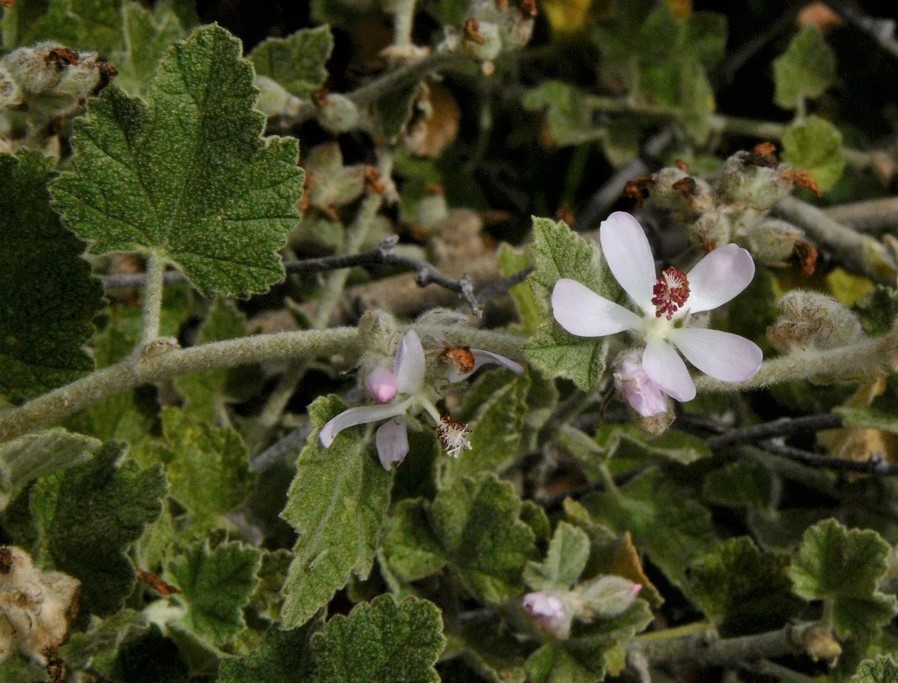
STATUS
Federal status: Endangered
State status: Endangered
POPULATION TREND
(+) Improving
RESTORATION
Favorable
FAMILY
Malvaceae, the hibiscus family
RANGE
Endemic to San Clemente Island
Appearance
This small shrub grows to between 50 cm and 1 m tall. Its hairy, five-lobed leaves are simple and grow alternate on the stem. The flowers are white to violet and blossom from March to August. They look similar to a smaller version of a five-petaled hibiscus flower.
Habitat
San Clemente Island bush mallow occurs on steep, rocky canyons in rock crevices and at the base of escarpments.
Threats
San Clemente Island bush mallow is threatened by military land use, erosion, non-native plants, and frequent fire.
Conservation
Since the removal of feral goats and pigs on San Clemente Island, this bush mallow species has expanded and is now found in seven locations on the island. Additional locations with suitable habitat for planting could be identified using fine-scale species distribution modeling.
Where can you spot it?
While this species is endemic to San Clemente Island, a healthy stand has been grown at the Huntington Botanic Garden in San Marino, California.
San Clemente Island Indian paintbrush, Castilleja grisea
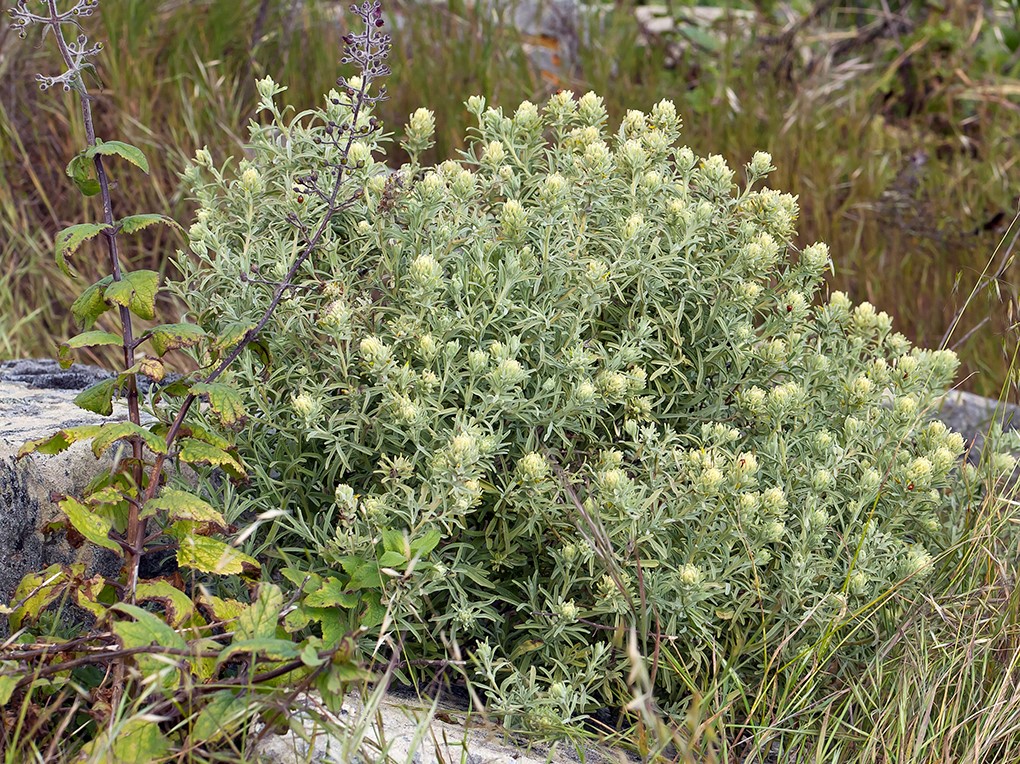
STATUS
Federal status: Threatened
State status: Endangered
POPULATION TREND
(+) Improving
RESTORATION
Intermediate
FAMILY
Orobanchaceae, a family of parasitic plants
RANGE
Endemic to San Clemente Island
Appearance
San Clemente Island Indian paintbrush is a perennial subshrub that grows 30 to 60 cm tall. It is typically covered in dense wooly felt. Its flowers are green to whitish-yellow and bloom between February and April.
Habitat
San Clemente Island Indian paintbrush is generally found on steep rocky canyons on the island, but can also be found on coastal bluffs, slopes, and flats around the island’s perimeter. Like other species of the genus Castilleja, San Clemente Island paintbrush is hemiparasitic, which means that its roots tap into the root system of other surrounding plants to acquire water and nutrients.
Threats
Current threats to San Clemente Island paintbrush include habitat destruction, erosion, non-native plant encroachment, and fires from Navy training activities. Military training itself could increase impacts to habitat as well, but a majority of San Clemente Island paintbrush occurrences fall outside of areas where intense disturbances occur.
Conservation
The Navy implements erosion control, fire management, and non-native species control plans to help mitigate threats to native plants. In order to ensure continued existence of this species and other rare plants, more systematic survey protocols would be useful for assessing population trends, fire tolerance, and the impacts of fire regimes.
Where can you spot it?
This species only occurs on San Clemente Island.
San Clemente Island larkspur, Delphinium variegatum ssp. kinkiense
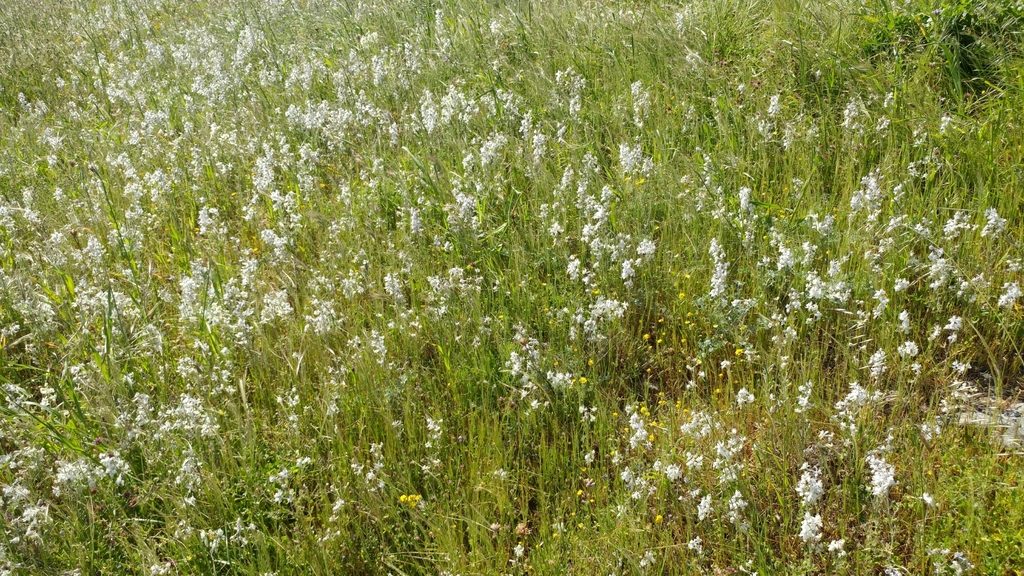
STATUS
Federal status: Endangered
State status: Endangered
POPULATION TREND
(+) Improving
RESTORATION
Intermediate
FAMILY
Ranunculaceae, the buttercup family
RANGE
Endemic to San Clemente Island
Appearance
This small perennial herb (10-50 cm tall) has three-part leaves and blue to white five-petaled flowers, which bloom from March to April.
Habitat
San Clemente Island larkspur prefers moist grasslands on rich, dark loam soils with relatively gentle slopes (< 15°).
Threats
Grazing by goats and rooting by feral pigs were historically the greatest threats to this larkspur species. Currently, fires and trampling on level terrain are major concerns.
Conservation
San Clemente Island larkspur was one of the first plant species to be listed following the passing of the Endangered Species Act. Two other endemic subspecies of larkspur occur on the island as well (D. variegatum ssp. kinkiense and thornei), which are just as, if not rarer, than ssp. kinkiensis. As there is some debate about subspecies classifications, conservation of all larkspur areas would be beneficial. Systematic surveys, analyses of population trends, and genetic studies are needed to secure the future of these species.
Where can you spot it?
This species is endemic to San Clemente Island.
San Clemente Island lotus, Acmispon dendroideus var. traskiae
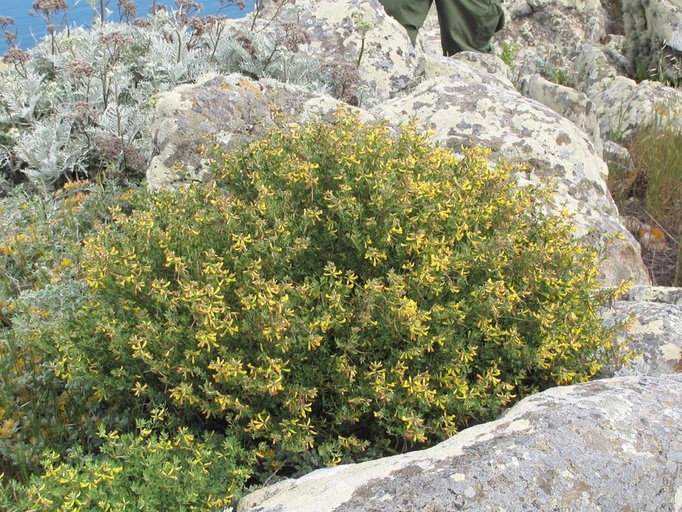
STATUS
Federal status: Threatened
State status: Endangered
POPULATION TREND
(+) Improving
RESTORATION
Favorable
FAMILY
Fabaceae, the pea family
RANGE
Endemic to San Clemente Island
Appearance
San Clemente Island lotus is a semi-woody subshrub that blooms from March to May. It has small, yellow flowers that turn orange and then red with age. Its leaves have 3 to 5 leaflets. This subspecies differs from other varieties of Acmispon dendroideus by its greatly elongated fruits.
Habitat
Coastal scrub, coastal bluff scrub, valley and foothill grassland on north-facing slopes, canyon bottoms, or ridgelines. It grows best around rock outcrops in grassy areas or along the interface between grassland and maritime sage scrub in well-drained soils, but where more soil moisture is available.
Threats
This was one of the first plants on the Endangered species list. Although populations have rebounded following the removal of feral grazers, its habitat remains degraded as a result of erosion, the invasion of non-native grasses, and possibly frequent and intense fires in the southern portion of its range. Hybridization between Acmispon dendroideus var. traskiae and the more common A. argophyllus var. adsurgens have occurred in Wilson Cove. However, hybridization between the two subspecies appears to be a somewhat rare event.
Conservation
Thanks to increases in occurrences and the complete removal of non-native mammal herbivores from its habitat, San Clemente Island lotus was recently reclassified from Endangered to Threatened, and is thus no longer considered to be in danger of extinction.
Where can you spot it?
This species is endemic to San Clemente Island.
San Clemente Island woodland star, Lithophragma maximum
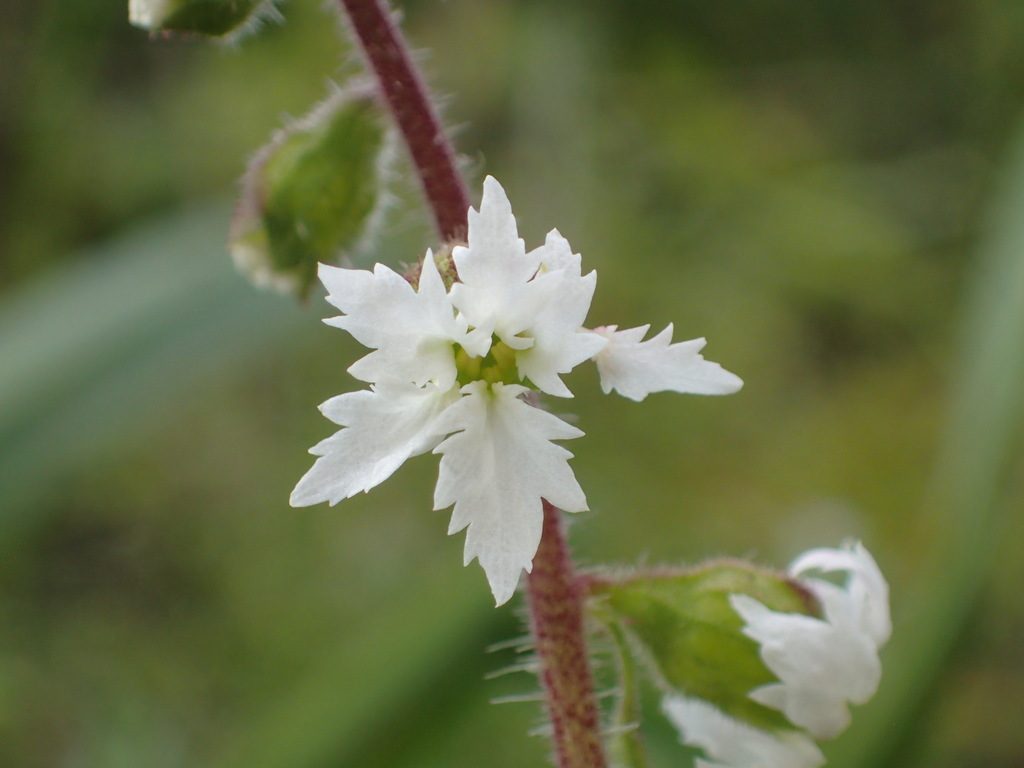
STATUS
Federal status: Endangered
State status: Endangered
POPULATION TREND
(+) Improving
RESTORATION
Intermediate
FAMILY
Saxifragaceae
RANGE
Endemic to San Clemente Island
Appearance
This perennial herb grows to 40 cm to 60 cm in height. In March to May, two to three flowering stalks rise from its basal leaves and produce white to pink-ish flowers with three lobed petals.
Habitat
San Clemente Island woodland star generally occurs on steep moist slopes in northern facing canyons.
Threats
San Clemente Island woodland star was thought to be extinct in the wild until a few individuals were rediscovered in 1979. Several hundred individuals have been identified since then, and a high degree of genetic diversity has been noted. However, populations are still small and occurrences tend to be separated by steep, branching canyons. Much of the species’ range lies in an area designated for bombing exercises and various military training activities. This has influenced fire frequencies in certain areas. The species is also threatened by soil loss and erosion (a legacy of the degradation caused by feral and domestic mammalian herbivores), as well as the presence of many dominant invasive non-native species.
Conservation
Conservation efforts should focus on preserving populations in multiple canyons, maintaining large population sizes to preserve genetic variation, and controlling the spread of invasive species at these sites.
Where can you spot it?
This species is endemic to San Clemente Island.
Santa Cruz Island rock cress, Sibara filifolia
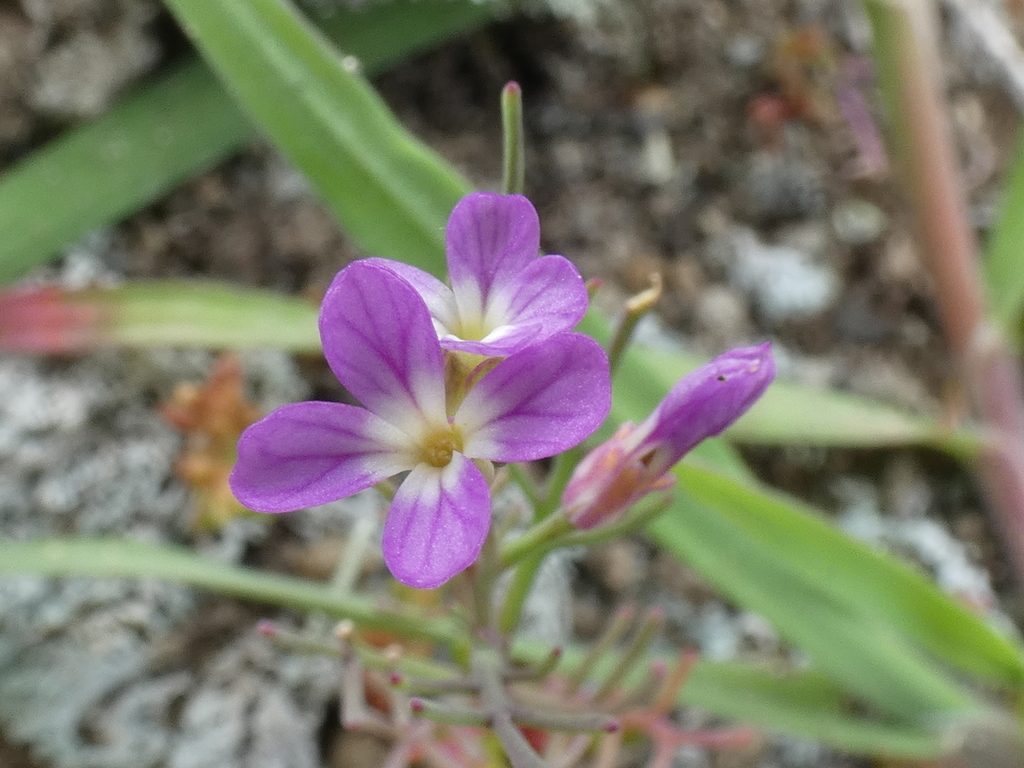
STATUS
Federal status: Endangered
POPULATION TREND
(=) Stable
RESTORATION
Difficult
FAMILY
Brassicaceae, the mustard family
RANGE
Endemic to the Channel Islands (found only on San Clemente Island and Santa Catalina Island)
Appearance
Santa Cruz Island rock cress is very small, annual herb that can be hard to spot because of its size (<5 cm). Leaves are finely divided into many linear lobes. The flowers occur from March to May and have pink/purple, spoon-shaped petals. The fruit is a long slender pod, similar to most mustards.
Habitat
Currently, it is only known to occur on saddles and sunny, volcanic screes, but historical populations were apparently found in shady places.
Threats
The main threats are invasion of non-native plants, frequent fires, and trampling.
Conservation
Non-native invasive plant control has been undertaken in Wild Boar Gulch. Other work, such as the establishment of seed banks, should be continued to preserve this species.
Where can you spot it?
Santa Cruz Island rock cress may be seen at Wild Boar Gulch in Santa Catalina Island. However, due to its small size and annual nature it would be difficult to see.
Island rush-rose, Crocanthemum greenei
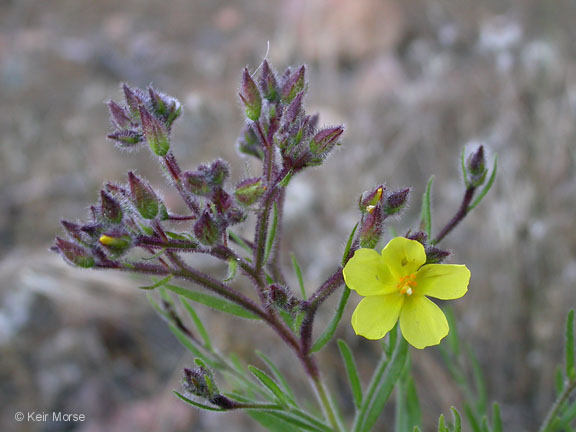
STATUS
Federal status: Threatened
POPULATION TREND
(+) Improving
RESTORATION
Intermediate
FAMILY
Cistaceae, the rock-rose family
RANGE
Endemic to the Channel Islands (found on Santa Cruz Island, Santa Rosa Island, Santa Catalina Island)
Appearance
Island rush-rose is a small shrub (0.5 meters) that blooms from March to July. It has yellow, five-petaled flowers and alternative leaves covered with star-shaped hairs.
Habitat
Island rush-rose occurs in a variety of habitats, including open, exposed areas in chaparral, coastal sage scrub, woodland, and island pine forest. It may be fire-dependent, as it is most common after fires.
Threats
Island rush-rose is vulnerable to soil damage, reduced fire frequencies and intensities, and grazing by non-native mammals.
Conservation
Herbivore management is a major part of Island rush-rose recovery. The removal of non-native herbivores and fire management have increased some population sizes of the Island rush-rose. Deer exclusion fences are needed around occurrences on Santa Catalina Island, and non-native mammal removals are needed on Santa Cruz island.
Where can you spot it?
Visit the Channel Islands National Park to see the Island rush-rose.
Data source:
Location data provided by the participants of the Consortium of California Herbaria.
References:
- California Department of Fish and Wildlife. “Catalina Island Mountain-Mahogany.” []ink]
- U.S. Fish and Wildlife Service. 2007. “Malacothamnus clementinus (San Clemente Island Bush Mallow) 5-Year Review: Summary and Evaluation.” U.S. Fish and Wildlife Service, Carlsbad Fish and Wildlife Office.
- California Department of Fish and Wildlife. “San Clemente Island Paintbrush.” [link]
- U.S. Fish and Wildlife Service. 2008. “Delphinium variegatum ssp. kinkiense (San Clemente Island Larkspur) 5-Year Review: Summary and Evaluation.” U.S. Fish and Wildlife Service, Carlsbad Fish and Wildlife Office.
- U.S. Fish and Wildlife Service. 2012. “5-Year Review Short Form Summary. Species Reviewed: Acmispon dendroideus var. traskiae (San Clemente Island lotus).”
U.S. Fish and Wildlife Service, Carlsbad Fish and Wildlife Office. - U.S. Fish and Wildlife Service. 2007. “Lithophragma maximum (San Clemente Island Woodland Star) 5-Year Review: Summary and Evaluation.” U.S. Fish and Wildlife Service, Carlsbad Fish and Wildlife Office.
- U.S. Fish and Wildlife Service. 2012. “Sibara filifolia (Santa Cruz Island rock-cress) 5-Year Review: Summary and Evaluation.” U.S. Fish and Wildlife Service, Carlsbad Fish and Wildlife Office, Carlsbad, California.
- U.S. Fish and Wildlife Service. 2010. “Helianthemum greenei (island rush-rose) 5-Year Review: Summary and Evaluation.” U.S. Fish and Wildlife Service, Ventura Fish and Wildlife Office, Ventura, California.